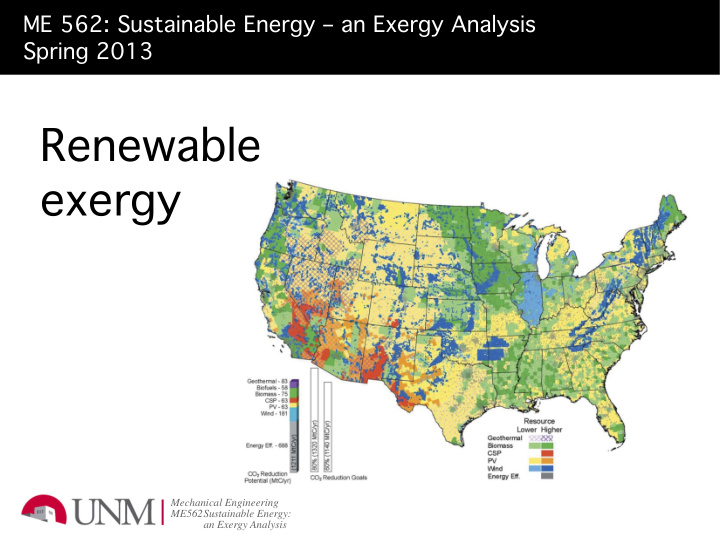



ME 562: Sustainable Energy – an Exergy Analysis Spring 2013 Renewable exergy Mechanical Engineering ME562Sustainable Energy: an Exergy Analysis
How much is there? short wave long wave solar radiation 174,000 TW tidal energy direct refmection 52,000 TW tides, tidal currents 3 TW direct conversion to heat 82,000 TW evaporation, precipitation Storage (water) 40,000 TW volcanoes & hot springs 0.3 TW wind, waves, convection & currents conduction 370 TW 32 TW decay photosynthesis Storage (plants) terrestrial energy animals 40 TW EARTH Fossil fuels Nuclear, thermal & gravitational energy 2 x 10 23 J Mechanical Engineering ME562Sustainable Energy: Renewables 2/30 an Exergy Analysis
Passive solar: the Trombe wall Mechanical Engineering ME562Sustainable Energy: Renewables 3/30 an Exergy Analysis
Low-temperature active Mechanical Engineering ME562Sustainable Energy: Renewables 4/30 an Exergy Analysis
Medium temperature - glazed Mechanical Engineering ME562Sustainable Energy: Renewables 5/30 an Exergy Analysis
High temperature - concentrating Mechanical Engineering ME562Sustainable Energy: Renewables 6/30 an Exergy Analysis
Solar collector effjciency Mechanical Engineering ME562Sustainable Energy: Renewables 7/30 an Exergy Analysis
The solar spectrum Mechanical Engineering ME562Sustainable Energy: Renewables 8/30 an Exergy Analysis
Measurement apparatus Mechanical Engineering ME562Sustainable Energy: Renewables 9/30 an Exergy Analysis
Terrestrial solar exergy fmows tropical humid mediterranean mountain tropical dry Mechanical Engineering ME562Sustainable Energy: Renewables 10/30 an Exergy Analysis
Different weather patterns cloudy day in summer sunny day in spring Mechanical Engineering ME562Sustainable Energy: Renewables 11/30 an Exergy Analysis
Geographic dependence of exergy Mechanical Engineering ME562Sustainable Energy: Renewables 12/30 an Exergy Analysis
Where does the exergy go? Mechanical Engineering ME562Sustainable Energy: Renewables 13/30 an Exergy Analysis
PV devices – mW to MW kW MW mW Mechanical Engineering ME562Sustainable Energy: Renewables 14/30 an Exergy Analysis
Where electrons live Mechanical Engineering ME562Sustainable Energy: Renewables 15/30 an Exergy Analysis
electrons demographics Mechanical Engineering ME562Sustainable Energy: Renewables 16/30 an Exergy Analysis
Valence and conduction bands Mechanical Engineering ME562Sustainable Energy: Renewables 17/30 an Exergy Analysis
The Silicon crystal structure Mechanical Engineering ME562Sustainable Energy: Renewables 18/30 an Exergy Analysis
Other possible PV materials Mechanical Engineering ME562Sustainable Energy: Renewables 19/30 an Exergy Analysis
PV cell structure Mechanical Engineering ME562Sustainable Energy: Renewables 20/30 an Exergy Analysis
Typical PV cells Mechanical Engineering ME562Sustainable Energy: Renewables 21/30 an Exergy Analysis
Typical performance curves Mechanical Engineering ME562Sustainable Energy: Renewables 22/30 an Exergy Analysis
The manufacturing process Mechanical Engineering ME562Sustainable Energy: Renewables 23/30 an Exergy Analysis
Single crystal ingot production Mechanical Engineering ME562Sustainable Energy: Renewables 24/30 an Exergy Analysis
A single crystal ingot Mechanical Engineering ME562Sustainable Energy: Renewables 25/30 an Exergy Analysis
Poly-Si ingot & cell Mechanical Engineering ME562Sustainable Energy: Renewables 26/30 an Exergy Analysis
Making little wafers Mechanical Engineering ME562Sustainable Energy: Renewables 27/30 an Exergy Analysis
Recommend
More recommend